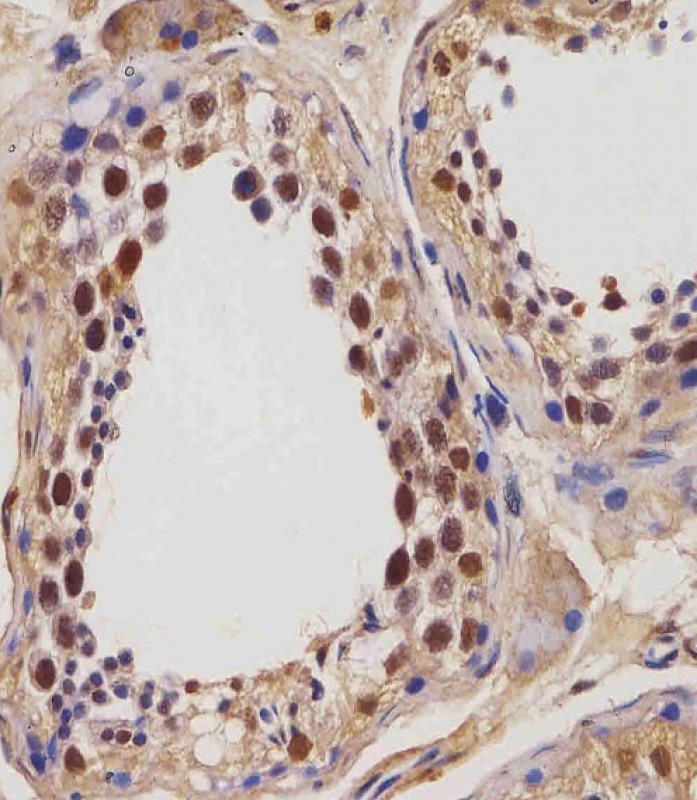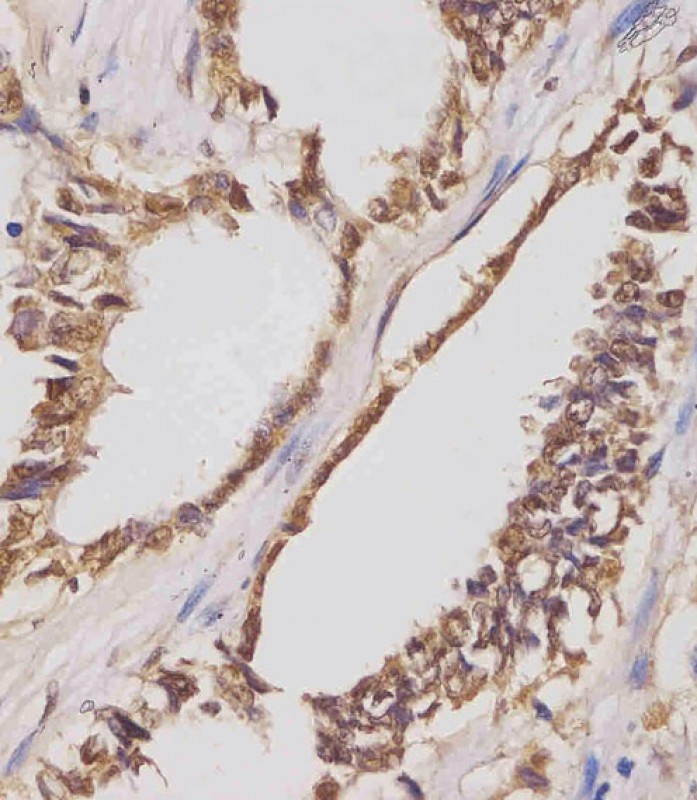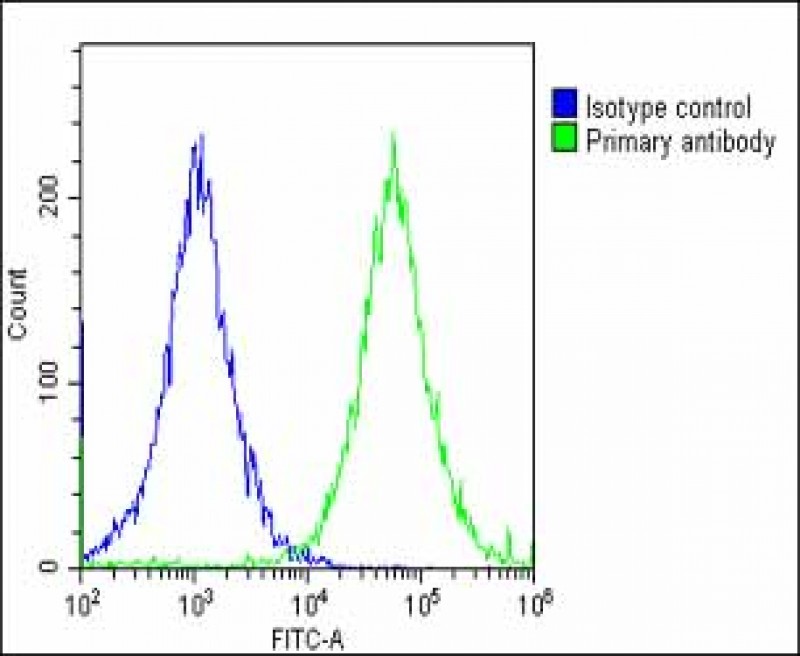IGF2BP1 Antibody (C-term)
Affinity Purified Rabbit Polyclonal Antibody (Pab)
- SPECIFICATION
- CITATIONS: 2
- PROTOCOLS
- BACKGROUND

Application
| WB, IHC-P, FC, E |
|---|---|
| Primary Accession | Q9NZI8 |
| Other Accession | Q9CPN8, O00425, Q9PW80, Q5ZLP8, Q8CGX0, O88477, O57526, NP_006537.3 |
| Reactivity | Human, Mouse |
| Predicted | Xenopus, Rat, Chicken, Zebrafish |
| Host | Rabbit |
| Clonality | Polyclonal |
| Isotype | Rabbit IgG |
| Calculated MW | 63481 Da |
| Antigen Region | 508-534 aa |
| Gene ID | 10642 |
|---|---|
| Other Names | Insulin-like growth factor 2 mRNA-binding protein 1, IGF2 mRNA-binding protein 1, IMP-1, IMP1, Coding region determinant-binding protein, CRD-BP, IGF-II mRNA-binding protein 1, VICKZ family member 1, Zipcode-binding protein 1, ZBP-1, IGF2BP1, CRDBP, VICKZ1, ZBP1 |
| Target/Specificity | This IGF2BP1 antibody is generated from rabbits immunized with a KLH conjugated synthetic peptide between 508-534 amino acids from the C-terminal region of human IGF2BP1. |
| Dilution | WB~~1:2000 IHC-P~~1:25 FC~~1:25 E~~Use at an assay dependent concentration. |
| Format | Purified polyclonal antibody supplied in PBS with 0.09% (W/V) sodium azide. This antibody is purified through a protein A column, followed by peptide affinity purification. |
| Storage | Maintain refrigerated at 2-8°C for up to 2 weeks. For long term storage store at -20°C in small aliquots to prevent freeze-thaw cycles. |
| Precautions | IGF2BP1 Antibody (C-term) is for research use only and not for use in diagnostic or therapeutic procedures. |
| Name | IGF2BP1 |
|---|---|
| Synonyms | CRDBP, VICKZ1, ZBP1 |
| Function | RNA-binding factor that recruits target transcripts to cytoplasmic protein-RNA complexes (mRNPs). This transcript 'caging' into mRNPs allows mRNA transport and transient storage. It also modulates the rate and location at which target transcripts encounter the translational apparatus and shields them from endonuclease attacks or microRNA-mediated degradation. Preferentially binds to N6- methyladenosine (m6A)-containing mRNAs and increases their stability (PubMed:29476152, PubMed:32245947). Plays a direct role in the transport and translation of transcripts required for axonal regeneration in adult sensory neurons (By similarity). Regulates localized beta-actin/ACTB mRNA translation, a crucial process for cell polarity, cell migration and neurite outgrowth. Co-transcriptionally associates with the ACTB mRNA in the nucleus. This binding involves a conserved 54-nucleotide element in the ACTB mRNA 3'-UTR, known as the 'zipcode'. The RNP thus formed is exported to the cytoplasm, binds to a motor protein and is transported along the cytoskeleton to the cell periphery. During transport, prevents ACTB mRNA from being translated into protein. When the RNP complex reaches its destination near the plasma membrane, IGF2BP1 is phosphorylated. This releases the mRNA, allowing ribosomal 40S and 60S subunits to assemble and initiate ACTB protein synthesis. Monomeric ACTB then assembles into the subcortical actin cytoskeleton (By similarity). During neuronal development, key regulator of neurite outgrowth, growth cone guidance and neuronal cell migration, presumably through the spatiotemporal fine tuning of protein synthesis, such as that of ACTB (By similarity). May regulate mRNA transport to activated synapses (By similarity). Binds to and stabilizes ABCB1/MDR-1 mRNA (By similarity). During interstinal wound repair, interacts with and stabilizes PTGS2 transcript. PTGS2 mRNA stabilization may be crucial for colonic mucosal wound healing (By similarity). Binds to the 3'-UTR of IGF2 mRNA by a mechanism of cooperative and sequential dimerization and regulates IGF2 mRNA subcellular localization and translation. Binds to MYC mRNA, in the coding region instability determinant (CRD) of the open reading frame (ORF), hence preventing MYC cleavage by endonucleases and possibly microRNA targeting to MYC-CRD (PubMed:29476152). Binding to MYC mRNA is enhanced by m6A-modification of the CRD (PubMed:29476152). Binds to the 3'-UTR of CD44 mRNA and stabilizes it, hence promotes cell adhesion and invadopodia formation in cancer cells. Binds to the oncofetal H19 transcript and to the neuron-specific TAU mRNA and regulates their localizations. Binds to and stabilizes BTRC/FBW1A mRNA. Binds to the adenine-rich autoregulatory sequence (ARS) located in PABPC1 mRNA and represses its translation. PABPC1 mRNA-binding is stimulated by PABPC1 protein. Prevents BTRC/FBW1A mRNA degradation by disrupting microRNA- dependent interaction with AGO2. Promotes the directed movement of tumor-derived cells by fine-tuning intracellular signaling networks. Binds to MAPK4 3'-UTR and inhibits its translation. Interacts with PTEN transcript open reading frame (ORF) and prevents mRNA decay. This combined action on MAPK4 (down-regulation) and PTEN (up-regulation) antagonizes HSPB1 phosphorylation, consequently it prevents G-actin sequestration by phosphorylated HSPB1, allowing F-actin polymerization. Hence enhances the velocity of cell migration and stimulates directed cell migration by PTEN-modulated polarization. Interacts with Hepatitis C virus (HCV) 5'-UTR and 3'-UTR and specifically enhances translation at the HCV IRES, but not 5'-cap-dependent translation, possibly by recruiting eIF3. Interacts with HIV-1 GAG protein and blocks the formation of infectious HIV-1 particles. Reduces HIV-1 assembly by inhibiting viral RNA packaging, as well as assembly and processing of GAG protein on cellular membranes. During cellular stress, such as oxidative stress or heat shock, stabilizes target mRNAs that are recruited to stress granules, including CD44, IGF2, MAPK4, MYC, PTEN, RAPGEF2 and RPS6KA5 transcripts. |
| Cellular Location | Nucleus. Cytoplasm. Cytoplasm, perinuclear region. Cytoplasm, P-body. Cytoplasm, Stress granule. Cell projection, lamellipodium. Cell projection, dendrite Cell projection, dendritic spine. Cell projection, growth cone. Cell projection, filopodium. Cell projection, axon. Note=In the nucleus, located in discrete foci, coinciding with the sites of ACTB transcription (By similarity). In the cytoplasm, localizes in cytoplasmic mRNP granules. Colocalizes with microtubules in growth cone filopodia and along neurites in neuronal cells (By similarity). Cytoplasmic colocalization with ACTB mRNA is partially lost at the cell periphery, suggesting release of the transcript. In neuronal processes, exhibits fast retrograde and anterograde movements, when associated with ACTB mRNA; this motility is lost when the association is inhibited (By similarity). In hippocampal neurons, predominantly located within dendrites, particularly at dendritic branching points in young cells, compared to axons (By similarity). In axons, predominantly found in axonal branches and their growth cones (By similarity). In motile cells, such as migrating fibroblasts, localizes to leading edges where it colocalizes with microtubules and microfilaments and to retracting tails (By similarity). Dendritic levels are regulated by neuronal activity and glutaminergic signals: they are increased by KCl-induced depolarization, which induces rapid efflux from the cell body into dendrites, and decreased by the NMDA receptor agonist (By similarity) In motile cells, transported towards the leading edge into the cortical region of the lamellipodia where it is connected to microfilaments (By similarity). In response to cellular stress, such as oxidative stress or heat shock, recruited to stress granules, but not to processing bodies. |
| Tissue Location | Mainly expressed in the embryo, including in fetal liver, fetal lung, fetal kidney, fetal thymus (at protein level). Also expressed follicles of ovary, as well as in gonocytes of testis, spermatogonia, semen, oocytes and placenta (at protein level) Expressed in various cancers, including testis and lung cancers (at protein level), as well as kidney, prostate and trachea cancers |

Provided below are standard protocols that you may find useful for product applications.
Background
IGF2BP1 is a member of the insulin-like growth factor 2 mRNA-binding protein family. The protein encoded by this gene contains four K homology domains and two RNA recognition motifs. It functions by binding to the mRNAs of certain genes, including insulin-like growth factor 2, beta-actin and beta-transducin repeat-containing protein, and regulating their translation. Two transcript variants encoding different isoforms have been found for this gene.
References
Rodriguez, S., et al. Growth Horm. IGF Res. 20(4):310-318(2010)
Pillas, D., et al. PLoS Genet. 6 (2), E1000856 (2010) :
Noubissi, F.K., et al. Cancer Res. 69(22):8572-8578(2009)
Zhou, Y., et al. Virology 393(2):210-220(2009)
Kawakami, Y., et al. Biosci. Biotechnol. Biochem. 73(8):1811-1817(2009)
If you have used an Abcepta product and would like to share how it has performed, please click on the "Submit Review" button and provide the requested information. Our staff will examine and post your review and contact you if needed.
If you have any additional inquiries please email technical services at tech@abcepta.com.














 Foundational characteristics of cancer include proliferation, angiogenesis, migration, evasion of apoptosis, and cellular immortality. Find key markers for these cellular processes and antibodies to detect them.
Foundational characteristics of cancer include proliferation, angiogenesis, migration, evasion of apoptosis, and cellular immortality. Find key markers for these cellular processes and antibodies to detect them. The SUMOplot™ Analysis Program predicts and scores sumoylation sites in your protein. SUMOylation is a post-translational modification involved in various cellular processes, such as nuclear-cytosolic transport, transcriptional regulation, apoptosis, protein stability, response to stress, and progression through the cell cycle.
The SUMOplot™ Analysis Program predicts and scores sumoylation sites in your protein. SUMOylation is a post-translational modification involved in various cellular processes, such as nuclear-cytosolic transport, transcriptional regulation, apoptosis, protein stability, response to stress, and progression through the cell cycle. The Autophagy Receptor Motif Plotter predicts and scores autophagy receptor binding sites in your protein. Identifying proteins connected to this pathway is critical to understanding the role of autophagy in physiological as well as pathological processes such as development, differentiation, neurodegenerative diseases, stress, infection, and cancer.
The Autophagy Receptor Motif Plotter predicts and scores autophagy receptor binding sites in your protein. Identifying proteins connected to this pathway is critical to understanding the role of autophagy in physiological as well as pathological processes such as development, differentiation, neurodegenerative diseases, stress, infection, and cancer.




